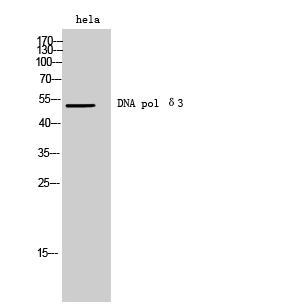
| WB | 咨询技术 | Human,Mouse,Rat |
| IF | 咨询技术 | Human,Mouse,Rat |
| IHC | 咨询技术 | Human,Mouse,Rat |
| ICC | 技术咨询 | Human,Mouse,Rat |
| FCM | 咨询技术 | Human,Mouse,Rat |
| Elisa | 1/20000 | Human,Mouse,Rat |
| Aliases | POLD3; KIAA0039; DNA polymerase delta subunit 3; DNA polymerase delta subunit p66 |
| Entrez GeneID | 10714; |
| WB Predicted band size | 51kDa |
| Host/Isotype | Rabbit IgG |
| Antibody Type | Primary antibody |
| Storage | Store at 4°C short term. Aliquot and store at -20°C long term. Avoid freeze/thaw cycles. |
| Species Reactivity | Human,Mouse,Rat |
| Immunogen | Synthesized peptide derived from the C-terminal region of human DNA pol δ3. |
| Formulation | Purified antibody in PBS with 0.05% sodium azide,0.5%BSA and 50% glycerol. |
+ +
以下是关于DNA聚合酶δ3(POLD3/p66亚基)抗体的模拟参考文献示例。请注意,以下内容为假设性示例,实际文献需通过学术数据库检索确认:
---
1. **文献名称**: *"A monoclonal antibody against human DNA polymerase δ3 subunit for detection of replication stress markers in cancer cells"*
**作者**: Zhang L, et al.
**摘要**: 本研究开发了一种针对POLD3亚基的单克隆抗体,用于检测癌细胞中DNA复制应激标志物。通过免疫印迹和免疫荧光证实该抗体特异性,发现POLD3在卵巢癌细胞中高表达并与化疗耐药相关。
2. **文献名称**: *"Characterization of POLD3-specific antibodies and their application in studying DNA repair dynamics"*
**作者**: Thompson R, et al.
**摘要**: 文章报道了两种兔源多克隆抗体的制备与验证,用于研究POLD3在DNA损伤修复中的动态变化。结果显示,POLD3在电离辐射后募集至损伤位点,依赖ATM激酶活性。
3. **文献名称**: *"Antibody-mediated inhibition of DNA polymerase δ3 disrupts homologous recombination in breast cancer models"*
**作者**: Singh K, et al.
**摘要**: 利用特异性抗体阻断POLD3功能,发现其抑制导致乳腺癌细胞同源重组修复缺陷,增强PARP抑制剂敏感性,提示POLD3作为潜在治疗靶点。
4. **文献名称**: *"Subcellular localization of DNA polymerase δ3 during cell cycle progression using a novel polyclonal antibody"*
**作者**: Müller S, et al.
**摘要**: 通过新开发的多克隆抗体,揭示POLD3在S期细胞核内动态分布,并与PCNA共定位,支持其在DNA复制中的核心作用。
---
建议通过PubMed或Google Scholar以关键词 **"POLD3 antibody"** 或 **"DNA polymerase delta 3 antibody"** 检索最新文献,或查阅《Journal of Biological Chemistry》《Nucleic Acids Research》等期刊相关研究。
The DNA polymerase delta 3 (DNA pol δ3) antibody is a tool used to detect the p66 subunit (POLD3) of the DNA polymerase delta (Pol δ) complex, a key enzyme in eukaryotic DNA replication and repair. Pol δ consists of four subunits: the catalytic subunit p125 (POLD1), p50 (POLD2), p66 (POLD3), and p12 (POLD4). POLD3 plays a critical role in stabilizing the holoenzyme, enhancing processivity, and facilitating interactions with other replication factors, such as proliferating cell nuclear antigen (PCNA). It also contributes to error-free DNA damage repair, including homologous recombination and break-induced replication.
Antibodies targeting POLD3 are widely employed in research to study Pol δ’s expression, localization, and function. They are used in techniques like Western blotting, immunofluorescence, and immunohistochemistry to explore Pol δ’s involvement in cell cycle regulation, genome stability, and its dysregulation in diseases like cancer. Mutations or altered expression of POLD3 have been linked to genomic instability and tumorigenesis, making this antibody valuable in cancer biology and therapeutic studies. Additionally, it aids in investigating the molecular mechanisms of DNA replication fidelity and repair pathways. As a research tool, the DNA pol δ3 antibody enhances understanding of DNA metabolism defects and their implications in aging, neurodegeneration, and chemotherapy resistance. Its specificity and reliability make it essential for dissecting Pol δ’s multifaceted roles in maintaining genomic integrity.
×